Thousands of seabirds, mostly Northern Gannets, nesting, “kissing,” swooping and calling out, cuddled together on sea stacks above the pounding ocean. In full sunshine we were the only birders on the narrow, grassy viewing area, a clifftop metres away from the birds, for four hours—late afternoon and again early the next morning. Viewing can become so crowded that a sign reads, “Please Assure Everyone Has an Equal Opportunity to View the Seabirds!” We may have been the luckiest people this summer to visit Cape St. Mary’s Ecological Reserve in Newfoundland, the most accessible seabird colony in North America.
We were skeptical entering the almost-empty parking lot—there was so much fog you could barely see the interpretative centre right in front of us.
“This is a rare day—there’s only one day in twenty-one that you can see our building from the parking lot,” said Chris Mooney, the interpretive centre officer, a solid guy dressed in park ranger khakis who looked like he could wrestle a bear, his welcome genuine, his Newfoundland wit as natural as his smile. It was 5:30 on a Friday night when we arrived, closing time for Chris. “You’ll have great visibility out on Bird Rock. Just be careful getting there. In the 21 years I’ve been here no one has fallen over the cliffs so don’t be the first because I have a lot to do at home and won’t take kindly to rescuing you.”
Cape St. Mary’s is home to 70,000 seabirds, mostly Northern Gannets. It’s the largest colony of them in Newfoundland and the southernmost of the world’s 40 known gannet colonies. And one of the most accessible. (If you don’t count the 13 km potholed single-lane road east from the small town of St. Bride’s. “They paved it in 1993 and I’ve been fixing potholes ever since,” Chris says. “I have to drive it every day!”) A 1.4 km hiking trail through sub-Arctic tundra leads from the interpretation centre to a grassy outcrop on the cliff adjacent to Bird Rock.
Bird Rock is like an avian high-rise condo. Over 11,000 nesting pairs of gannets live in the penthouses, dumping their sewage onto the homes below. In addition to the gannets, there are more than 10,000 pairs of Common Murres, 10,000 pairs of Black-Legged Kittiwakes, 150 pairs of Razorbills (although we didn’t see any) and 60 pairs of black Guillemot Cormorants.
When male gannets find a suitable breeding spot, they attempt to attract a female. To show their availability females fly over the colony with their necks outstretched signalling they’re available for courtship. In return the males shake their heads in a similar way to when they’re guarding the nest but instead of stretching their wings, they stay closed. Gannets are monogamous, staying with the same bird over many years, if not their entire lives.
The couples produce one chick and take turns doting first on the egg and then the chick, fending off predators such as eagles, gulls and other gannets while their mate gathers food at sea, a daily scene from spring until late September. When the male arrives back at the nest, the two birds stand breast-to-breast with wings spread and bills extended vertically. They fence and scissor with their bills rapidly, calling loudly at the same time.
When ready to fledge, the chicks glide down into the sea and because they are so heavy, they are unable to return to the cliff. Their reserves of fat allow them to go two-to-three weeks without eating. The juveniles migrate as far as the Gulf of Mexico, returning to their birth area after two or three years. Immature birds stay on the edge of the colony and may attempt to build a nest but they don’t breed until they are four or five years old.
After the chicks have fledged the adults separate and spread out over a wide area, spending their winters alone, often 1600 kilometres away from their breeding colony.
After our second viewing, we returned to the Interpretive Centre to see the excellent exhibits and learn more from Chris.
His team had an immediate concern—the possible extent of avian bird flu. That Saturday a 73-year-old specialist from Boston was coming out and they were going to take blood samples. Chris had set the ropes so they could climb down the ledges. “Before we just took feces’ samples, shoved a tube up their arse,” said Chris. “A Northern Gannet colony in Britain was almost wiped-out after sick juveniles had returned from South Africa.”
It’s a very serious problem that we’ll address in a subsequent blog.
NAVIGATION
Every Year Thousands of Northern Gannets Return to This Crowded Rock Ledge in Newfoundland – CBC
Gannet life in Newfoundland, Canada Cornell Lab of Ornithology’s Conservation Media Program





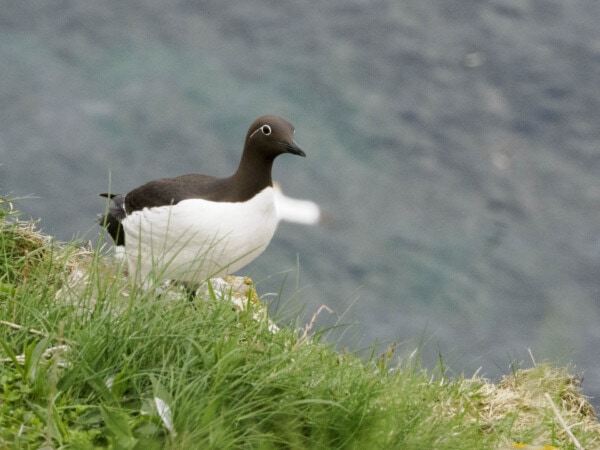


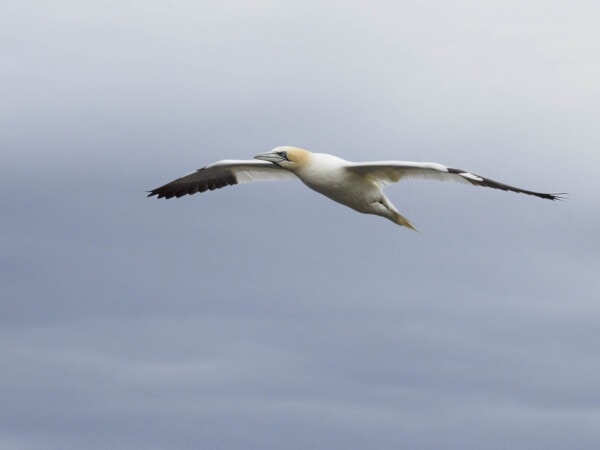
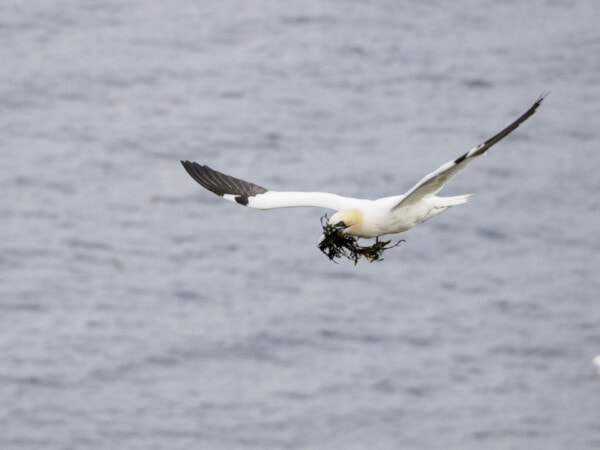
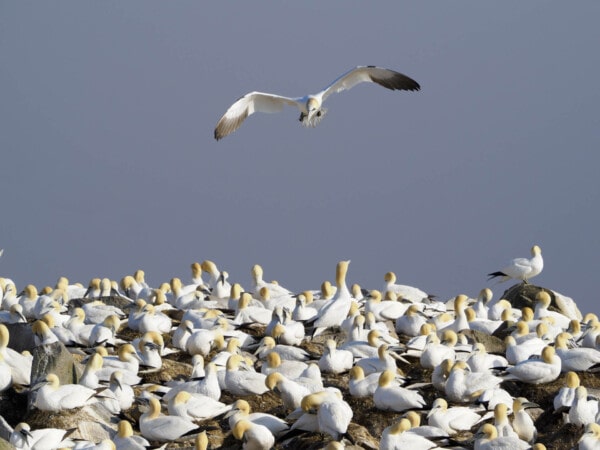
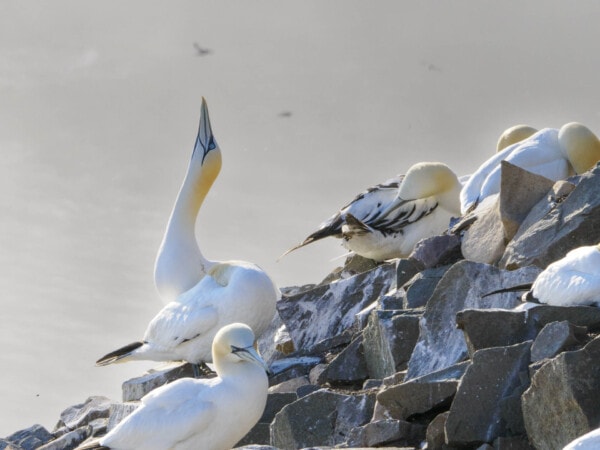

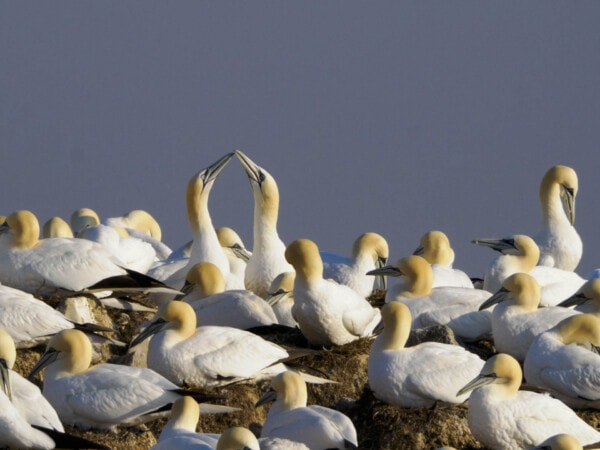

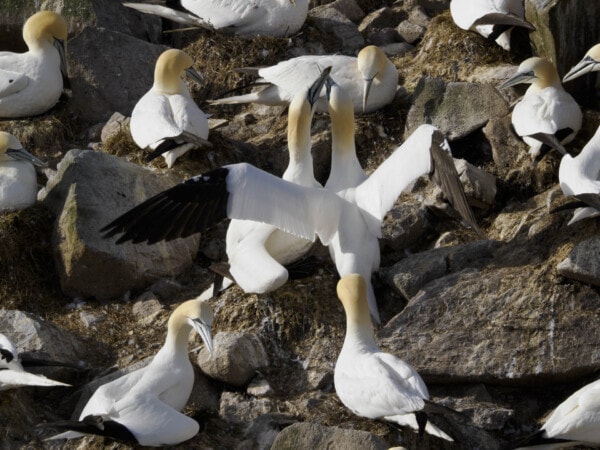

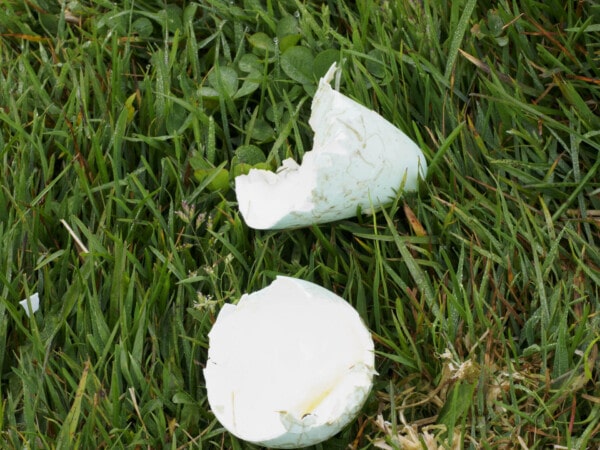

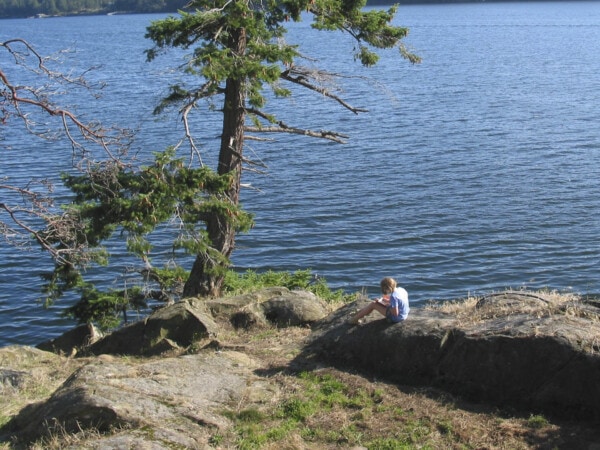





16 Responses
Incredible pics, video and documentary!
Thank you
Barry
Magellan’s work, mostly on this one.
Oh yes!
Fascinating video, shows how smart and social they are.
Our Navigation link to Gannets: The Honeybees of the Sea speculates the gannet’s dance contains information on feeding grounds—an avian analogue of the famous honeybee waggle dance.
The gannets not only perform complex bill-fencing, preening, and head-bobbing rituals during mating, but also every time they return from a foraging trip at sea.
A new study led by researchers from the University of Montpellier in France and the University of Cape Town in South Africa showed that heavy preeners had fed to the west of the colony on prey kicked up by fishing trawlers off the continental shelf; whereas lighter preening indicated feeding to the south, where sardines, a natural prey species, are found.
Wow! Great video and photos. Loved it all.
It’s an ad for “Come to Newfoundland” isn’t it?
Ahhhmazing AMAZING photographs!! So beautiful 🤩 So interesting to me how nature encompasses the whole gamut from the sublime to the ridiculous…what could be more perfectly beautiful and elegant than those birds? Their colouring, the shape of their bodies, those wings!! And then they live on a rock splattered with poo!
Quite magical too that Magellan found them among the thousands and focused on the avian world’s Grace Kelly and her prince.
Except for the landscapes, Spice shot all of the still images in this post. The auto-focus for birds-in-flight on her Olympus OM1 was incredible–it just locked onto the bird’s eye. I was so jealous, for our subsequent trip to Iceland and pending trip to Alaska, I upgraded to the same OM1 body. And we are sharing a new lens for those times when the subject is a bit far away–a 100-400mm with a 2x teleconverter, giving the equivalent reach of 1600 mm from a full frame camera! And at less than half the weight.
Thanks for the wonderful photos and video, well done!
Speaking of bird viruses, when West Nile virus was more prevalent here, the corvids (crows, magpies) almost disappeared from here. I got it too, but didn’t disappear. The corvids are back now, thankfully. Plus, more ravens have been moving here.
It’s amazing how these colonies have been able to recover after experiencing a wreck. They’re quite resilient.
Yes tha gannets in Scotland, always great stories…Thanks for sharing…Heather
I didn’t realize the St Kilda was 60 km west of the Isle of Lewis–that is remote! It has the world’s largest colony of northern gannets with about 150,000 living on it at peak season. As of June 2022, they had recorded 1,000 gannets dead from flu, and potentially many magnitudes more unrecorded.
Interested story and reminds me of St Kilda in Scotland, similar bird species and very remote area on the coast creates more than a few similarities.
Bird flu is becoming more and more prevalent, I am sure as we near major turkey season, it’s effect will become only to familiar. 💸💸💸💸💸
So nice to have such a spot to yourself, quite the racket they are capable of providing, nice to see Mother Nature surviving with such numbers.
Thanks, as always, for sharing your travels. 👍👍👍☃️☃️☃️
To be by ourselves at Cape St. Mary’s was magical.
However, like COVID for humans, the avian flu is a global disaster. As of the end of November in the UK, 600,000 free range turkeys and geese have died or been culled, half of the supply. The U.S. Center for Disease Control just reported that more than 49 million birds in 46 states have either died as a result of bird flu virus infection or have been culled due to exposure to infected birds since early 2022. In BC, the B.C. Poultry Association is reporting a 20% drop in supply of turkeys, so we’ve already ordered a pheasant for Christmas.
For the St. Mary’s seabird colony, they won’t know the extent until the birds return in the spring of 2023.